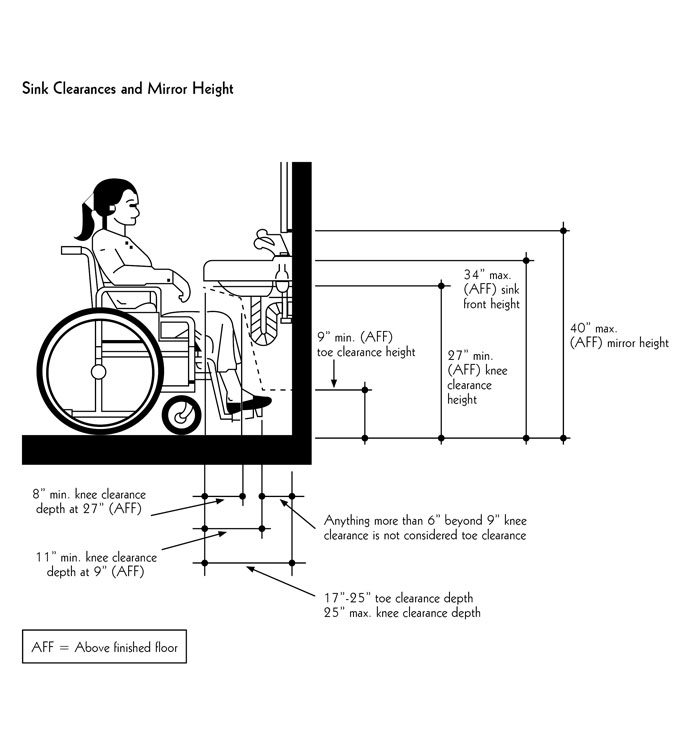Standard Bathroom Sink Height in the USA
The height of a bathroom sink might not seem like a critical element in bathroom design, but it significantly impacts the user's comfort and functionality. In the United States, a standard height for bathroom sinks has emerged over time, influenced by ergonomic considerations and building codes. Understanding this standard and the factors that can lead to deviations is essential for both homeowners and contractors during bathroom renovations or new construction.
This article delves into the established standard bathroom sink height in the USA, exploring its origins, the reasoning behind it, and common variations encountered in different bathroom setups. It also examines accessibility requirements and alternative height considerations for specific user needs.
The Accepted Standard Height
The generally accepted standard height for bathroom sinks in the United States is 31 to 36 inches from the floor to the top of the sink rim. This measurement is intended to provide a comfortable height for the average adult, minimizing back strain and promoting a natural posture while washing hands or performing other grooming tasks. Historically, the lower end of this range (31-32 inches) was more prevalent, stemming from older building practices and average height calculations from previous generations. However, as the average height of the population has increased and ergonomic awareness has improved, the higher end of the range (34-36 inches) has become increasingly common, particularly in new constructions and modern renovations.
The selection within this 31-36 inch range often depends on the specific sink type. For example, vessel sinks, which sit on top of the countertop, typically require a lower vanity height to maintain the overall sink rim height within the standard range. Undermount sinks, which are installed beneath the countertop, allow for a slightly higher vanity height.
It is important to note that this standard primarily refers to the finished height of the sink rim after installation. This includes the height of the vanity or cabinet beneath the sink, as well as the thickness of the countertop, if applicable. Accurate measurements during the planning and installation stages are critical to achieving the desired final sink height.
Factors Influencing Sink Height Choices
While the 31-36 inch range provides a general guideline, several factors can influence the ultimate decision regarding bathroom sink height. These factors include the user's height, the presence of children in the household, accessibility requirements, and aesthetic preferences.
For taller individuals, a higher sink height might be more comfortable, reducing the need to bend over excessively. Conversely, for shorter individuals, a lower sink height might be more suitable. In households with children, a compromise might be necessary, or a separate step stool could be provided to facilitate access for younger users. Alternatively, dual-height sinks can be installed, offering both a standard height and a lower height option within the same bathroom space.
The Americans with Disabilities Act (ADA) sets specific guidelines for accessible bathroom design, including sink height. According to ADA standards, the top of the sink rim should be no higher than 34 inches above the floor for accessible sinks. Additionally, the under-sink area must be designed to provide adequate knee clearance for wheelchair users. This typically involves an open space beneath the sink with a minimum height and depth requirement.
Aesthetic considerations also play a role in sink height choices. The overall design style of the bathroom, including the type of vanity, countertop material, and sink style, can influence the perceived height and functionality of the sink. A sleek, modern bathroom might benefit from a higher sink height to create a more contemporary feel, while a traditional bathroom might opt for a lower sink height that aligns with classic design principles.
Plumbing considerations can also influence sink height. The location of existing plumbing lines, particularly the drainpipe, might limit the range of possible sink heights. Relocating plumbing can be costly and time-consuming, so it is often necessary to work within the constraints of the existing plumbing infrastructure.
Accessibility and ADA Compliance
The Americans with Disabilities Act (ADA) mandates specific requirements for accessible bathrooms, including the height and configuration of bathroom sinks. The ADA Standards for Accessible Design aim to ensure that individuals with disabilities can use bathroom facilities with ease and independence.
As previously mentioned, the maximum height of the sink rim for an ADA-compliant sink is 34 inches above the finished floor. This height is designed to be accessible to individuals using wheelchairs or other mobility aids. In addition to the height requirement, the ADA also specifies the need for clear floor space around the sink and adequate knee and toe clearance beneath the sink.
The clear floor space must be at least 30 inches wide and 48 inches deep, allowing a wheelchair user to approach the sink head-on. The knee clearance must be at least 27 inches high, 30 inches wide, and 8 inches deep at the knee, and at least 9 inches high above the floor and 11 inches deep at the toe. These clearances allow a wheelchair user to roll under the sink and access the faucet and other controls comfortably.
To comply with ADA standards, the plumbing and drainpipes beneath the sink must be insulated or otherwise configured to protect users from burns. Sharp or abrasive surfaces under the sink must also be avoided. The faucet controls should be easy to operate with one hand and require minimal force. Lever-style or electronic faucets are often preferred in accessible bathrooms.
It is important to note that ADA compliance is typically required in public accommodations and commercial buildings, such as restaurants, hotels, and office buildings. While ADA standards are not always mandatory in private residences, they can serve as a valuable guide for creating accessible and user-friendly bathrooms for individuals with disabilities or mobility limitations.
In summary, achieving ADA compliance involves a careful consideration of sink height, clearances, and plumbing details to ensure that the bathroom sink is accessible and safe for all users.
Alternatives to Standard Height Sinks
While the standard sink height of 31-36 inches works well for many users, alternative heights might be more appropriate in certain situations. These alternatives include vessel sinks, wall-mounted sinks, and adjustable-height sinks, each offering unique advantages and disadvantages.
Vessel sinks, which sit on top of the countertop rather than being installed beneath it, can create a distinctive visual appeal. However, because the sink bowl adds to the overall height, the vanity or cabinet must be shorter to maintain the standard sink rim height. This can result in reduced storage space beneath the sink. Carefully calculating the combined height of the vessel sink and the vanity is crucial to achieve a comfortable and functional sink height.
Wall-mounted sinks offer a clean and minimalist aesthetic and can be installed at a variety of heights. This flexibility makes them a good option for bathrooms with limited space or for users who require a specific sink height. However, wall-mounted sinks typically lack storage space, and the plumbing fixtures are often exposed, requiring careful attention to aesthetics.
Adjustable-height sinks provide the ultimate flexibility, allowing users to customize the sink height to their individual needs. These sinks are typically mounted on a frame that can be raised or lowered with a manual crank or an electric motor. Adjustable-height sinks are particularly useful in multi-user bathrooms or for individuals with varying physical abilities. However, they can be more expensive and require more complex installation than standard sinks.
Another alternative is the use of different countertop thicknesses. A thicker countertop will naturally raise the overall sink height, while a thinner countertop will lower it. This is a subtle but effective way to fine-tune the sink height to achieve the desired ergonomic comfort.
The choice of alternative sink height depends on a variety of factors, including user preferences, accessibility requirements, budget, and aesthetic considerations. Consulting with a qualified bathroom designer or contractor can help homeowners determine the best option for their specific needs.
Ultimately, the optimal bathroom sink height is one that promotes comfort, functionality, and accessibility for all users. While the standard height provides a useful starting point, it is important to consider individual needs and preferences when making a final decision.

What Is The Standard Bathroom Vanity Height Size Guide

What Is The Standard Bathroom Vanity Height Size Guide

What Is The Standard Height Of A Bathroom Vanity

What Is The Standard Height Of A Bathroom Vanity

Ada Compliant Bathroom Sinks And Restroom Accessories Laforce Llc

What Is The Standard Bathroom Sink Height

What Is The Standard Height Of A Bathroom Vanity

Bathroom And Restroom Measurements Standards Guide

How To Choose Your Bathroom Vanity Height

Bathroom Measurement Guide These Are The Measurements You Need To Know
Related Posts







